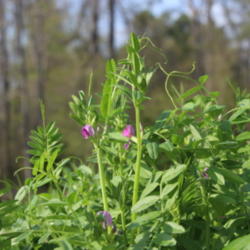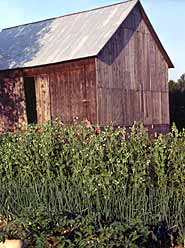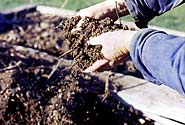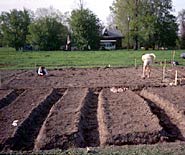
To paraphrase a famous campaign slogan: "It's the soil, stupid." Meaning, of course, that--no matter what varieties you plant, or how you stake, feed, water, and pamper them--it's all for naught if your soil is not in good condition. (And, even if your soil seems to be in prime condition, it can always stand improving from year to year.)
Know Your SoilFortunately, it's not too late to tend to the soil wherever you garden. We talked to several soil experts around the country, and though they all have their own preferred methods of soil improvement, they agree on one thing: start with a soil test. Otherwise you're flying blind. As John Dromgoole tells his customers, at Garden-Ville nursery in Austin, Texas, "If you want me to help you, I need a road map."
Not all soil tests are the same, however. Dromgoole recommends using a service that provides recommendations in terms of organic fertilizers. A complete test should also reveal the organic matter content of your soil. It's usually less than it should be. "Most of the soil tests that we do, we find about a 1 percent level of organic matter," says Denny Schrock, home horticulture specialist at the University of Illinois. "We'd like to see something closer to 5 percent, but if we get 3 percent, we're pretty happy."
Even more important than knowing the fertility of your soil is knowing its texture--whether it's sand, silt, clay, or something else--says Richard Merrill, director of the horticulture department at Cabrillo Community College in Aptos, California. Testing the texture is something that every gardener can do at home.
To get a general idea of your soil texture, you can perform the ribbon test. Take a handful of moist soil and roll it between your palms until it forms a ribbon. If it feels gritty and breaks apart immediately, the soil is predominately sand. If the soil feels smooth, and holds its shape for a short time before breaking apart, it's mostly silt. However, if it feels sticky and holds together in a ribbon, then it's clay.
Even without knowing the soil's exact texture, it's a safe bet that adding organic matter will help. The only question is how you're going to do it.

Compost is fine, says Richard Merrill, but he maintains that the most effective way to add organic matter to the soil is through green manures and cover crops. They get the job done without expending all the energy it takes to make and spread compost. And many types of cover crops offer a secondary benefit. "Not only are you adding organic matter," he says, "but cover crops such as buckwheat attract beneficial insects to the garden as well."
However, there is a tradeoff. Though cover crops may save energy, they use up space in the garden. "And, of course, gardeners don't like to waste space," says Merrill. But he suggests that the space is well spent and can be managed easily. "You can use a rotation plan to plant cover crops in strips or beds or boxes," he says. And a fast-growing crop like buckwheat can be in and out in eight weeks, allowing you to sow other crops soon afterward.
"We've developed our own rotation here," he says. "In summer we use buckwheat (Polygonum fagopyrum), Sudan grass (Sorghum sudanense), and sunn hemp (Crotalaria juncea). Then in fall we plant vetch (Vicia), sweet clover (Melilotus alba), and bell beans (Vicia faba)." He suggests that home gardeners start with a single crop of a warm-weather green manure, preferably buckwheat. "You can easily use it in your regular rotation. For example, if you have four boxes, plant vegetables in three and buckwheat in one, and rotate them." This works for any part of the country because buckwheat is a good warm-weather cover crop.
Buckwheat is easy to grow and easy to turn in, and it doesn't develop tough tissue as vetch does. The only difficulty that gardeners may have is deciding when and how to turn in the cover crop. Merrill believes that most gardeners wait too long, and consequently the cover crops contain too much carbon. He suggests turning buckwheat under early, when about 10 percent of it is in flower. And you don't have to do it all at once; just begin digging in strips when it reaches that point.
With buckwheat, the harvesting is easy. Just chop it off at ground level and lay it on the ground to serve as a mulch. "Sure, some of the nutrients will volatilize," Merrill says. "But we don't worry too much about that." Or, you can cut it off at ground level rake it up, and compost it. The most efficient way to use all of the nutrients is to cut the top growth and dig it into the soil along with the roots. But you'll need a tiller if you're doing more than about 2,000 square feet. Once it's all turned in, you can immediately replant with a crop.

Of course, using compost is another very effective way to improve the soil. Where clay rules, says Denny Schrock, the best thing you can do is add organic matter. "You can use composted manure, homemade compost, municipal compost, sawdust composted with manure--they're all good products. If you work in a good amount in the spring, it will improve the soil structure when you're planting." It's important to use only finished, completely decomposed, compost in spring.
How much is a good amount? "There's no such thing as too little," Schrock says. "Every little bit helps." But it is possible to add too much organic matter, especially to clay soil. "The problem with too much organic matter in the soil is that you can get shrinkage (a condition that occurs as the organic matter decomposes and the soil literally shrinks, resulting in cracks), and you'll wind up with huge gaps in the soil." So, as a rule of thumb, Schrock says don't add more than a third of the volume of the soil at any one time. "For example if you're going to work the soil to 6 inches deep, add a 3-inch layer of organic matter, and work it in thoroughly." What's the best way to work it in? "Get someone else to do it for you," Schrock quips. Failing that, you can use any tool, from a spade to a tiller.

Working amendments into the soil offers a good opportunity to build raised beds. "Raised beds offer several benefits," says Denny Schrock. "In heavy clay, just raising the soil helps to improve drainage." Those beds can be as simple or elaborate as you choose. "In my vegetable garden, I have what I call temporary raised beds," Schrock says. "I just dig out the walkways and mound up the soil between them. That way I can change the configuration from year to year. But in a perennial flower bed, you might want something more permanent and decorative. You can use landscape timbers for a more rustic look, or you might want to use interlocking concrete blocks."
Though he knows it can benefit the soil, Schrock doesn't bother with double digging. "I always say it's a wonderful thing to do for anyone with a weak enough mind and a strong enough back. It certainly helps, but it takes a lot of work." However, he suggests a double-digging shortcut you can use when constructing raised beds. "You can dig the first (original) layer of soil as you normally would," Schrock says. "Then add a layer of amended soil, and work that in thoroughly through the original layer of soil to root depth. It's important that the organic matter is worked all the way through the soil, or you'll wind up with a perched water table." Simply tossing on a layer of organic matter can actually result in problems: layers of wet and dry areas with different porosity prevent water from penetrating the soil uniformly.
MulchBy April in Texas, the soil has been worked, and the first crop is growing. But it's not too late to improve the soil with organic matter. "The best way to do that is with mulch," says John Dromgoole. "What's most important here is to make sure that the garden will perform well going into the extreme heat of the summer. A 4-inch layer of mulch drops our soil temperature from 105°F to 80°F--just like that." At the same time, it contributes organic matter and nutrients to the soil as it decomposes. Regardless of where you garden, you can still improve soil even once you're growing in it.
"For a mulch, we want something that lies flat and stays tight on the soil," Dromgoole says. "If it's loose, it creates a good habitat for pillbugs and slugs and other pests." Coastal Bermuda grass hay has always been a popular choice for mulch in Texas, "but we don't recommend it anymore," Dromgoole says, "because we found some that was contaminated with a broadleaf herbicide. If you use it on your vegetable garden, the production gradually decreases. Instead, we recommend pine needles. They do have kind of an open habit, but if you apply them in May, once the plants are established, the pillbugs and slugs can't do as much damage."
Mulch and compost burn up quickly in the hot Texas summers, but Dromgoole has found a way to make his compost go a long way: build a little dam of earth around each plant, then put compost in the little basin created by the dam. That helps to save water, too, by focusing it where it should be. And whenever you water, you're constantly feeding with a compost tea.
Dromgoole also relies on regular applications of greensand, a mineral fertilizer, to toughen up the plants. "We've found that applications of greensand are very important. The available potassium in it increases hardiness of plants going into the heat of summer. I apply a full cup per [mature] plant, and it's very beneficial."
If you're going to add only one amendment, make it kelp meal, says Bill Wolf, president of the board of directors of the Organic Materials Review Institute. "Kelp or seaweed is a great source of trace minerals and growth elements. Just apply 1 pound per 100 square feet at any time during the growing season," he says. Adding seaweed triggers an increase in microbial activity and fuels the decay cycle of organic matter in the soil. It doesn't take much to get things cooking.
According to Wolf, there is one overlooked ingredient in soil health. "The most important fertility component in your soil--more important than anything you can buy--is air. Air is the driving force in stimulating soil life. Microorganisms, earthworms, biotic activity, all rely on a good supply of air."
That's the reason for the standard caution against working the soil too early in the year. Tilling wet soil will destroy its structure, compact the soil, and squeeze out the air. "When you compress the air out of the soil, you kill everything in it. So treat your soil gently," Wolf advises. "Don't overtill, and don't even walk on it when it's wet."
By mulching, cover cropping, and composting, you can work on the soil all season long. You don't have to break your back at the start of the year trying to get it all done right then. In fact, you can tend your soil through the season, just as you tend your plants.
Home Soil AuditBill Wolf, president of the board of directors of the Organic Materials Review Institute, suggests gardeners audit their soil like this: In spring, while soil is moist and warm (at least 55°F), find an area of the garden where the ground is covered by mulch or green manure, and dig up a chunk 1 foot square by 6 inches deep. Place the soil on a piece of wood or cardboard, and count the earthworms in the mass of soil. If you find 10 or more earthworms, your soil has good fertility.
Warren Schultz lives in Essex, Vermont and has been a frequent contributor to National Gardening.
Photography by Bill Lorenz and National Gardening Association.